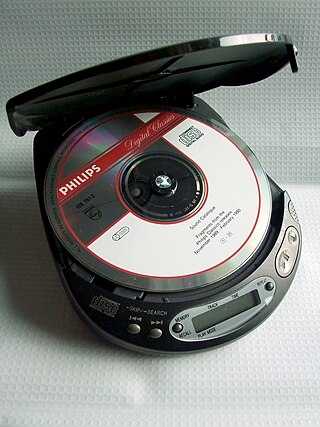Related Research Articles

A CD player is an electronic device that plays audio compact discs, which are a digital optical disc data storage format. CD players were first sold to consumers in 1982. CDs typically contain recordings of audio material such as music or audiobooks. CD players may be part of home stereo systems, car audio systems, personal computers, or portable CD players such as CD boomboxes. Most CD players produce an output signal via a headphone jack or RCA jacks. To use a CD player in a home stereo system, the user connects an RCA cable from the RCA jacks to a hi-fi and loudspeakers for listening to music. To listen to music using a CD player with a headphone output jack, the user plugs headphones or earphones into the headphone jack.
iRiver, stylized IRIVER and formerly as iriver, is a South Korean consumer electronics division owned by Dreamus which markets music and other accessories in its domestic market.

The Rio PMP300 is one of the first portable consumer MP3 digital audio players, and the first commercially successful one. Produced by Diamond Multimedia, it was introduced September 15, 1998 as the first in the "Rio" series of digital audio players, and it shipped later that year.

The Personal Jukebox was the first consumer hard drive-based digital audio player. Introduced in 1999, it preceded the Apple iPod, SanDisk Sansa, and other similar players. It was designed and developed by Compaq Research starting in May 1998. Compaq did not release the player themselves, but licensed the design to HanGo Electronics Co., Ltd. of South Korea.

ZEN is a series of discontinued portable media players designed and manufactured by Creative Technology Limited. The players evolved from the NOMAD brand through the NOMAD Jukebox series of music players, with the first separate "ZEN" branded models released in 2004. The last Creative Zen player, X-Fi3, was released at the end of 2011.
Neuros Technology was a Chicago, Illinois–based company that produced a number of audio and video devices under the brand name Neuros. Founded by Joe Born in 2001 as a division of Digital Innovations, it previously operated under the name Neuros Audio. Like Digital Innovations, Neuros distinguished itself by its use of open-innovation and crowdsourcing techniques to bring products to market, as well as by its prominent use of open-source software and open-source hardware. In its development model, end users were involved throughout the product development process from reviewing initial concepts to beta testing initial product releases.

A portable media player (PMP) or digital audio player (DAP) is a portable consumer electronics device capable of storing and playing digital media such as audio, images, and video files. The data is typically stored on a compact disc (CD), Digital Versatile Disc (DVD), Blu-ray Disc (BD), flash memory, microdrive, SD cards or hard drive; most earlier PMPs used physical media, but modern players mostly use flash memory. In contrast, analogue portable audio players play music from non-digital media that use analogue media, such as cassette tapes or vinyl records.
Gapless playback is the uninterrupted playback of consecutive audio tracks, such that relative time distances in the original audio source are preserved over track boundaries on playback. For this to be useful, other artifacts at track boundaries should not be severed either. Gapless playback is common with compact discs, gramophone records, or tapes, but is not always available with other formats that employ compressed digital audio. The absence of gapless playback is a source of annoyance to listeners of music where tracks are meant to segue into each other, such as some classical music, progressive rock, concept albums, electronic music, and live recordings with audience noise between tracks.
Archos is a French multinational electronics company that was established in 1988 by Henri Crohas. Archos manufactures tablets, smartphones, portable media players and portable data storage devices. The name is an anagram of Crohas' last name. Also, in Greek (-αρχος), it's a suffix used in nouns indicating a person with power. The company's slogan has been updated from "Think Smaller" to "On The Go", and the current "Entertainment your way".

The Rio Carbon is a line of digital audio players that was produced by the now defunct Rio from 2004 to 2005. It was similar in size, capacity, and cost with Apple's iPod Mini which debuted earlier the same year. This was Rio's second player to use a miniature hard disk for storage, after the Rio Nitrus, which was first to market with a 1.5 GB drive in late 2003.

SonicStage is a discontinued software product from Sony that is used for managing portable devices when they are plugged into a computer running Microsoft Windows. It comprises a music player and library manager, similar to iTunes, Windows Media Player and RealPlayer. It is used to manage the library of ATRAC and MP3 recordings on a PC.

Rio was a line of digital audio players and related audio products. Its first release, the Rio PMP300 digital music player, released by Diamond Multimedia in 1998, was one of the earliest notable and commercially successful devices in its category. It also became known as the target of an early lawsuit regarding the legality of such devices. Following the PMP300, various music players were released under the Rio brand name by a number of companies until the brand was retired in 2005.

SigmaTel, Inc., was an American system-on-a-chip (SoC), electronics and software company headquartered in Austin, Texas, that designed AV media player/recorder SoCs, reference circuit boards, SoC software development kits built around a custom cooperative kernel and all SoC device drivers including USB mass storage and AV decoder DSP, media player/recorder apps, and controller chips for multifunction peripherals. SigmaTel became Austin's largest IPO as of 2003 when it became publicly traded on NASDAQ. The company was driven by a talented mix of electrical and computer engineers plus other professionals with semiconductor industry experience in Silicon Hills, the number two IC design region in the United States, after Silicon Valley.
The Rio Receiver was a home stereo device for playing MP3 files stored on your computer's hard drive over an Ethernet or HomePNA network. It was later rebranded and sold as the Dell Digital Audio Receiver.
The TrekStor Vibez is a microdrive digital audio player released on November 15, 2006. It is available in 8 GB and 12 GB capacities.

The ZEN V and the ZEN V Plus are portable media players manufactured by Creative Technology. The user interface on this player, the same as the one on Creative's ZEN Vision:M, was patented by Creative on January 9, 2005. Creative sued Apple over the use of this user interface; Apple later settled for $100 million.

Asus EeeBox PC is a nettop computer line from ASUSTeK Computer Incorporated, and a part of the Asus Eee product family. First released on August 11, 2008, the Asus EeeBox PC series is marketed as a small, light, inexpensive and energy-efficient counterpart to the Asus Eee PC netbook / subnotebook laptop series. Its motherboard employs Splashtop technology called Express Gate by Asus.

The Dingoo is a handheld gaming console that supports music and video playback and open game development. The system features an on-board radio and recording program. It was sold to consumers in three colors: white, black, and pink. It was released in February 2009 and had sold over 1 million units.

The GP2X Caanoo, more commonly known as Caanoo, stylized CAANOO, is an open source, Linux-based handheld video game console and portable media player developed by the South Korean company GamePark Holdings. It was released on August 16, 2010 in South Korea and were also sold throughout Europe. It is the successor to the GP2X Wiz, and was showcased at the Electronic Entertainment Expo 2010. The device's launch price was about US$150, which didn't reach any retail stores in North America.
The French consumer electronics company Archos manufactured a number of products which have since been discontinued.
References
- 1 2 Clarke, Peter (2 June 1999). "Engineers drive craze for MP3 audio players". EETimes. Retrieved 22 May 2022.
- 1 2 Bailey, Alasdair (May 2000). "Whatever happened to... Hugo Fiennes?". Acorn User. pp. 24–25. Retrieved 22 May 2022.
- ↑ Lal Shimpi, Anand (September 2000). "MP3 meets Car Audio: Empeg Mark II in-dash Car MP3 Player". AnandTech. pp. 24–25. Retrieved 13 March 2023.
- ↑ Heffernan, Cameron; Crotty, Cameron (November 1999). "You Say You Want a Revolution". PC World. pp. 199–203, 206–207. Retrieved 22 May 2022.
- ↑ Shim, Richard (5 November 2000). "Sonicblue picks up audio manufacturer empeg". ZDNet. Retrieved 14 October 2022.
- ↑ Smith, Tony (30 August 2005). "Rio owner quits MP3 player market". The Register. Retrieved 14 October 2022.